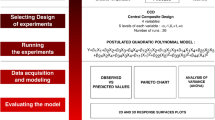Abstract
The scheelite concentrate was leached with a mixture of sulfuric and oxalic acids. Chemical compositions, mineral phases, and morphology were characterized by XRF, XRD, and SEM–EDS. Based on the results of the single-factor experiments, the response surface methodology (RSM) was chosen to optimize the leaching parameters: temperature, time, and concentrations of sulfuric and oxalic acids. The RSM results indicate that the optimum values for those parameters are as follows: temperature 72 ℃, sulfuric acid concentration 1.48 mol/L, oxalic acid concentration 0.96 mol/L, and reaction time 2 h. Under the optimal leaching conditions, the model predicts a maximum leaching yield of 99.5%, compared to the value of 99.1% obtained experimentally, that is, a discrepancy of only 0.04%. This good correlation shows that the quadratic polynomial equation obtained by the RSM optimization is reliable. The importance on leaching parameters of scheelite is, in decreasing order, temperature, time, sulfuric acid concentration, and oxalic acid concentration.








Similar content being viewed by others
References
Song YF, He LH, Chen XY et al (2017) Removal of tungsten from molybdate solution by Fe-Mn binary oxide absorbent [J]. The chinese journal of nonferrous metals 27(11):2492–2502
Bohlouli A, Afshar MR, Aboutalebi MR, Seyedein SH (2016) Optimization of tungsten leaching from low manganese wolframite concentrate using response surface methodology (RSM) [J]. Int J Refract Metal Hard Mater 61:107–114
Martins JI (2003) Leaching of synthetic scheelite by nitric acid without the formation of tungstic acid [J]. Industry Engineering Chemistry Research 42:5031–5036
Lin-sheng WANG, Xiao-jing HUANG, Deng-fei DENG, Hong-chao LI, Yao-ming CHEN (2015) Synthesis of scheelite from sodium tungstate solution by calcium hydroxide addition [J]. Hydrometallurgy 154:17–19
Zhao ZW, Li JT, Wang SB et al (2011) Extracting tungsten from scheelite concentrate with caustic soda by autoclaving process[J]. Hydrometallurgy 108(1-):152–156
Gürmen S, Timur S, Arslan C, Duman I (1999) Acidic leaching of scheelite concentrate and production of hetero-poly-tungstate salt [J]. Hydrometallurgy 51:227–238
Shen Leiting, Li Xiao-bin, Zhou Qiusheng, Taskinen Pekka (2018) Kinetics of scheelite conversion in sulfuric acid. JOM: the journal of the Minerals, Metals & Materials Society 70(11):2499–2504
Martins JI, Moreira A, Costa SC (2003) Leaching of synthetic scheelite by hydrochloric acid without the formation of tungstic acid. Hydrometallurgy 70:131–141
Zhang WJ, Yang JH, Zhao ZW et al (2016) Coordination leaching of tungsten from scheelite concentrate with phosphorus in nitric acid[J]. J Cent South Univ 23:1312–1317
Li JT, Zhao ZW (2016) Kinetics of scheelite concentrate digestion with sulfuric acid in the presence of phosphoric acid[J]. Hydrometallurgy 163:55–60
Huang J, Xie FH, Xiao HJ et al (2014) Coordination leaching of scheelite ore by HCl-H3PO4[J]. Chinese journal of rare metals 38(4):703–710
Zhang WJ, Li JT, Zhao ZW (2015) Leaching kinetics of scheelite with nitric acid and phosphoric acid[J]. International journal of refractory metals and hard metals 52:78–84
Ilhan S, Kalpakli AO, Kahruman C et al (2013) The investigation of dissolution behavior of gangue materials during the dissolution of scheelite concentrate in oxalic acidsolution[J]. Hydrometallurgy 136:15–26
Azizid D, Shafaei SZ, Noaparast M et al (2012) Modeling and optimization of low-grade Mn bearing ore leaching using response surface methodology and central composite rotatable design[J]. The chinese journal of nonferrous metals 22(9):2295–2305
Li D, Park K, Wu Z et al (2010) Response surface design for nickel recovery from laterite by sulfation-roasting-leaching process[J]. The chinese journal of nonferrous metals 20(S1):92–96
Kalpakli AO, Ilhan S, Kahruman C et al (2012) Dissolution behavior of calcium tungstate in oxalic acid solutions[J]. Hydrometallurgy 121:7–15
Qiu TS, Yan HS, Li JF et al (2018) Response surface method for optimization of leaching of a low-grade ionic rare earth oxide[J]. Powder Technol 330:330–338
Yang LS, Wang JX, Sun XH et al (2019) Multi-objective optimization design of spiral demister with punched holes by combining response surface method and genetic algorithm[J]. Powder Technol 355:106–118
Swamy GJ, Sangamithr A, Chandrasekar V (2014) Response surface modeling and process optimization of aqueous extraction of natural pigments from Beta vulgaris using Box-Behnken design of experiments[J]. Dyes Pigm 111:64–74
Aslan N (2008) Application of response surface methodology and central composite rotatable design for modeling and optimization of a multi-gravity separator for chromite concentrate[J]. Powder Technol 185:80–86
Boulifi NF, Aracil J, Martinez M (2010) Lipase-catalyzed synthesis of isosorbide monori-noleate: process optimization of response surface methodology[J]. Powder Technology 101:8520–8525
Zuo YF, Li P, Tu RR et al (2019) Optimization the process conditions for preparing dialdehyde starch with high aldehyde content by acidolysis oxidation based on response surface methodology[J]. Materials reports 33(1):335–341
Yan H, Peng WJ, Wang ZX et al (2013) Reductive leaching technology of manganese annode slag optimized by response surface methodology[J]. The Chinese journal of Nonferrous Metals 23(2):528–534
Yao FH, Guang SH, Yang H et al (2019) Long-term deformation analysis of Shuibuya concrete face rockfill dam based on response surface method and improved genetic algorithm[J]. Water Science and Engineering 12(3):196–204
Gomez F, Sartaj M (2014) Optimization of field scale biopiles for bioremediation of petroleum hydrocarbon contaminated soil at low temperature conditions by response resurface methodology(RSM)[J]. Int Biodeterior Biodegradation 89:103–109
Abdollahi H, Shafaei SZ, Noaparast M et al (2013) Bio-dissolution of Cu, Mo ad Re from molybdenite concentrate using mix mesophilic microorganism in shake flask[J]. Transactions of nonferro us metals society of china 23:219–230
Funding
This work was supported by the National Natural Science Foundation (Grant Nos. 51564019 and 51674125) and the Science and Technology Project of Jiangxi Province Education Department (Grant No. GJJ181501).
Author information
Authors and Affiliations
Corresponding author
Additional information
Publisher's Note
Springer Nature remains neutral with regard to jurisdictional claims in published maps and institutional affiliations.
Rights and permissions
About this article
Cite this article
Tu, T., Guo, H., Liu, Q. et al. Response Surface Method Optimization of Mixed Acid Leaching Parameters for Scheelite Concentrate. Mining, Metallurgy & Exploration 38, 2537–2546 (2021). https://doi.org/10.1007/s42461-021-00484-x
Received:
Accepted:
Published:
Issue Date:
DOI: https://doi.org/10.1007/s42461-021-00484-x




